Related Research Articles
Protected areas of Tasmania consist of protected areas located within Tasmania and its immediate onshore waters, including Macquarie Island. It includes areas of crown land managed by Tasmanian Government agencies as well as private reserves. As of 2016, 52% of Tasmania's land area has some form of reservation classification, the majority is managed by the Tasmania Parks & Wildlife Service. Marine protected areas cover about 7.9% of state waters.
The Forestry Commission is a non-ministerial government department responsible for the management of publicly owned forests and the regulation of both public and private forestry in England.
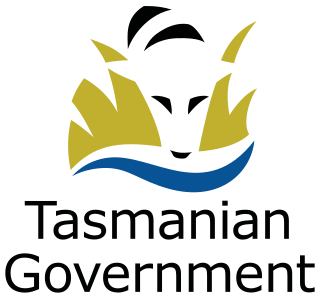
The Tasmanian Government or the Government of Tasmania is the executive branch of the Australian state of Tasmania. The leader of the party or coalition with the confidence of the House of Assembly, the lower house of the Parliament of Tasmania, is invited by the governor of Tasmania to form the executive. The governor appoints the premier of Tasmania.
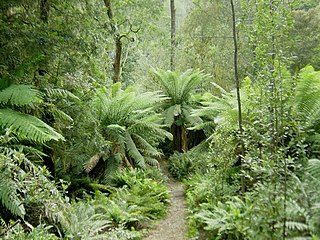
The Tarkine, officially takayna / the Tarkine, is an area containing the Savage River National Park in the north west Tasmania, Australia, which contains significant areas of wilderness. The Tarkine is noted for its beauty and natural values, containing the largest area of Gondwanan cool-temperate rainforest in Australia, as well as for its prominence in Tasmania's early mining history. The area's high concentration of Aboriginal sites has led to it being described by the Australian Heritage Council as "one of the world's great archaeological regions".

The Wielangta forest is in south-east Tasmania, Australia. It is notable for its role in a 2006 court case that called into question the effectiveness of Australia's cooperative Commonwealth-State forest management regime known as Regional Forest Agreements.
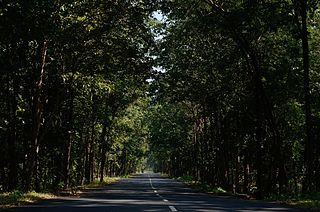
Social forestry is the management and protection of forests and afforestation of barren and deforested lands with the purpose of helping environmental, social and rural development. The term social forestry was first used in 1976 by The National Commission on Agriculture, when the government of India aimed to reduce pressure on forests by planting trees on all unused and fallow lands. It was intended as a democratic approach to forest conservation and usage, maximizing land utilization for multiple purposes.
The Department of Natural Resources and Environment Tasmania is the government department of the Tasmanian Government responsible for supporting primary industry development, the protection of Tasmania's natural environment, effective land and water management and the protection of Tasmania's relative disease and pest free status. NRE's responsibilities also include maintaining the security of land tenure, administration of much of the state's Crown lands and delivery of government services through Service Tasmania.

Forestry Tasmania trades as Sustainable Timber Tasmania but is still legally called Forestry Tasmania. It is a government business enterprise wholly owned by the Government of Tasmania, Australia. It is responsible for the management of public production forest in Tasmania, which is about 800,000 hectares of crown land that is classified as 'permanent timber production zone'.

Deforestation is one of the most serious environmental issues in Sri Lanka. Sri Lanka's current forest cover as of 2017 was 29.7%. In the 1920s, the island had a 49 percent forest cover but by 2005 this had fallen by approximately 26 percent. Between 1990 and 2000, Sri Lanka lost an average of 26,800 ha of forests per year. This amounts to an average annual deforestation rate of 1.14%. Between 2000 and 2005 the rate accelerated to 1.43% per annum. However, with a long history of policy and laws towards environmental protection, deforestation rates of primary cover have decreased 35% since the end of the 1990s thanks to a strong history of conservation measures. The problem of deforestation in Sri Lanka is not as significant in the southern mountainous regions as it is in northern and lowland southern Sri Lanka, largely due to the nature of environmental protection.
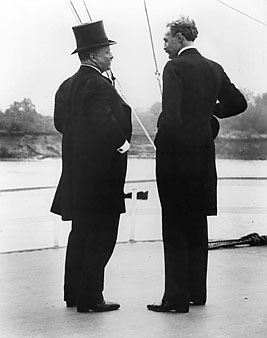
Starting in 1876, and undergoing a series of name changes, the United States Forest Service of the Department of Agriculture grew to protect and use millions of acres of forest on public land. Gifford Pinchot, an early advocate of scientific forestry, along with President Theodore Roosevelt and conservation organizations, led the effort to manage forest for the public good.
Forestry in Tasmania Australia has been conducted since early European settlement. The logging of old growth native forests in the state has been opposed by environmentalists and others via means such as lobbying, legislation and blockades.
The Tasmanian Forests Intergovernmental Agreement (TFIA) is an agreement between the Commonwealth of Australia and the State of Tasmania. It is designed to create additional areas of forest reserves in the State of Tasmania, while ensuring ongoing wood supply for the forest industry. It was signed by Australian Prime Minister, Julia Gillard, and Tasmania's Premier, Lara Giddings, on August 7, 2011.
The Alabama Forestry Commission (AFC) is the forest management agency for the U.S. state of Alabama. It was created as a state agency by an act of the Alabama Legislature in 1924. Its general mission is protecting Alabama's forests from wildfire, insects, and diseases; assisting landowners practice responsible forest management on their private property; and educating the general public about the value of Alabama's forests. It established the Alabama Champion Tree Program in 1970 and continues to maintain it.
The Department of State Growth is a Tasmanian Government department.
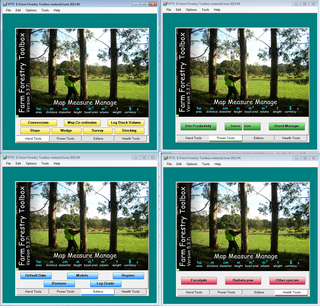
The Farm Forestry Toolbox is a collection of computer programs, referred to as 'Tools', intended to be used by farm forest owners and managers to aid decision making. The Toolbox includes a set of simple 'Hand Tools'; conversion of measurements and map co-ordinates; measuring the volume of stacked logs, slope, basal area; and a survey tool. A second set of more complex tools or 'Power Tools'; can be used to estimate site productivity, volume and value of wood grown for individual trees, at the coupe or stand level and forest estate level.
The Private Forests Act 1994, established an Authority to provide assistance and advice on private forest management, to prescribe the functions and powers of that authority, to provide for related matters and to amend certain Acts. The Act created Private Forests Tasmania, a body corporate with perpetual succession, with seal and may sue and be sued in its corporate name.
A private timber reserve is an area of privately owned land, used or intended to be used, for growing timber within the Australian state of Tasmania.

The Tasmanian Environmental Protection Authority is an independent regulatory body of the Tasmanian Government responsible for the environmental protection and management in the state of Tasmania, Australia. The EPA's primary role is to independently monitor, regulate, and enforce environmental laws and regulations to ensure the protection of Tasmania's natural resources and ecosystems.
The Victorian Plantations Corporation (VPC) of Victoria, Australia, was established under the State Owned Enterprises Act in May 1993, and by June 1993 was declared a State Business Corporation.
References
- 1 2 3 "Private Forests Act 1994". TheLaw. State of Tasmania. Retrieved 13 July 2015.
- ↑ "Government Departments and Programs". Farm Forest Online. Farm Forest Online. Retrieved 13 July 2015.
- ↑ "View - Tasmanian Legislation Online". www.legislation.tas.gov.au. Retrieved 20 November 2023.
- ↑ "Private Forests Act 1994" (PDF). pft.tas.gov.au. 1 January 2020. Retrieved 20 November 2023.
- ↑ "Funding Sources". PFT. PFT. Archived from the original on 9 July 2015. Retrieved 13 July 2015.
- ↑ Felton, Ken. "The Companion to Tasmanian History - Forestry". The Companion to Tasmanian History: First Edition. Centre for Tasmanian Historical Studies University of Tasmania. Retrieved 13 September 2016.
- ↑ Everett, M.G.; Gentle, S.W (July 1997). Report of the Board of Inquiry into Private Forestry Development in Tasmania. Hobart. ISBN 0724603379.
{{cite book}}: CS1 maint: location missing publisher (link) - ↑ Private Forestry in Tasmania 1978-1988: Achievements of the Decade. Hobart: Forestry Commission. 1988. ISBN 0724635122.
- ↑ Commonwealth Competitive Neutrality Complaints Office (CCNCO) 2001, Competitive Neutrality in Forestry, CCNCO Research Paper, Productivity Commission, Canberra, May 2001. Chapter 2 Forestry background and institutional framework p 14 Table 2.3
- ↑ "Private Forests Tasmania Annual Report 2014-2015" (PDF). Private Forests Tasmania. Private Forests Tasmania. Retrieved 12 September 2016.
- ↑ "We're growing the future". Tree Alliance. Retrieved 20 November 2023.